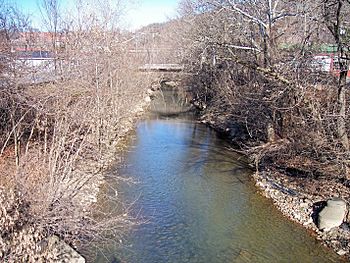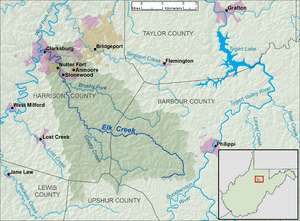Elk Creek (West Virginia) facts for kids
Quick facts for kids Elk Creek |
|
|---|---|

Elk Creek in Clarksburg in 2006
|
|

Elk Creek and its watershed
|
|
| Country | United States |
| State | West Virginia |
| Counties | Barbour, Harrison |
| Physical characteristics | |
| Main source | Barbour County, West Virginia 1,535 ft (468 m) 39°06′32″N 80°08′07″W / 39.10889°N 80.13528°W |
| River mouth | West Fork River Clarksburg, West Virginia 922 ft (281 m) 39°16′55″N 80°21′06″W / 39.28194°N 80.35167°W |
| Length | 29 mi (47 km) |
| Basin features | |
| Basin size | 121 sq mi (310 km2) |
Elk Creek is a river in north-central West Virginia, USA. It flows for about 29 miles (47 km). Elk Creek is a small river that flows into a larger one, the West Fork River.
From there, its waters travel through the Monongahela and Ohio Rivers. Finally, they join the mighty Mississippi River. This means Elk Creek is part of the huge watershed of the Mississippi River. It drains an area of about 121 square miles (310 km2). This area is part of the Allegheny Plateau, a high, flat land that was not covered by glaciers long ago.
People believe the river was named by an 18th-century trapper and hunter named John Simpson. He saw many elk along the stream.
Where Elk Creek Flows
Elk Creek starts about 6 miles (9.7 km) southwest of Philippi. This is in western Barbour County. From there, it flows generally toward the west-northwest.
It then enters Harrison County. Along its path, it passes through the towns of Stonewood and Nutter Fort. Elk Creek eventually flows into the West Fork River in the city of Clarksburg.
Land Around the Creek
The land around Elk Creek is mostly covered by forest. About 70% of the area is deciduous forest, meaning trees that lose their leaves in the fall.
About 22% of the land is used for farms and pastures. Only about 3% of the area is covered by cities or towns. This information comes from the West Virginia Department of Environmental Protection.
The Story Behind the Name
The hunter and trapper John Simpson gave Elk Creek its name. He also named a nearby stream, Simpson's Creek.
A writer from the 1800s, Alexander Scott Withers, shared a story about John Simpson. Simpson was traveling with two brothers, John and Samuel Pringle. They were soldiers who had left the army during the French and Indian War.
In 1764, Simpson and the Pringle brothers decided to travel deeper into the wilderness. Simpson wanted to find new hunting grounds. The Pringles wanted to stay hidden from other people.
They crossed the Cheat River at a place called the Horse Shoe. There, Simpson and one of the Pringle brothers had a fight. Even though they needed to get along for safety, they got very angry. This led them to separate.
Simpson then crossed the [Tygart] Valley River. He went to the start of another stream and named it Simpson's Creek. After that, he traveled west and found a stream he called Elk Creek.
He built a camp at the mouth of Elk Creek. He lived there for over a year without seeing anyone else. After that time, he went to the South Branch to sell his furs and skins. Then he returned to his camp at the mouth of Elk Creek. This spot is now the city of Clarksburg. He stayed there until more people started to settle in the area.

